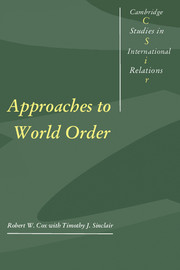Book contents
- Frontmatter
- Contents
- Preface
- Acknowledgements
- Part I Overviews
- Part II Theory
- Part III Interpretations
- 10 The global political economy and social choice (1991)
- 11 “Real socialism” in historical perspective (1991)
- 12 Structural issues of global governance: implications for Europe (1991)
- 13 Middlepowermanship, Japan, and future world order (1989)
- 14 Production and security (1993)
- 15 Global perestroika (1992)
- Part IV Multilateralism
- Complete bibliography of works by Robert W. Cox to 1995
- Index of names
- Index of subjects
- CAMBRIDGE STUDIES IN INTERNATIONAL RELATIONS
15 - Global perestroika (1992)
Published online by Cambridge University Press: 05 June 2012
- Frontmatter
- Contents
- Preface
- Acknowledgements
- Part I Overviews
- Part II Theory
- Part III Interpretations
- 10 The global political economy and social choice (1991)
- 11 “Real socialism” in historical perspective (1991)
- 12 Structural issues of global governance: implications for Europe (1991)
- 13 Middlepowermanship, Japan, and future world order (1989)
- 14 Production and security (1993)
- 15 Global perestroika (1992)
- Part IV Multilateralism
- Complete bibliography of works by Robert W. Cox to 1995
- Index of names
- Index of subjects
- CAMBRIDGE STUDIES IN INTERNATIONAL RELATIONS
Summary
Mikhail Gorbachev's perestroika was a revolution from above, a decision by political leadership to undertake a reform of the economic organization of “real socialism” which, once initiated, got out of control and spun into entropy. Underlying that decision was a vague idea that some kind of socialism could be rebuilt in the context of market forces. No one had a clear strategy based upon real social forces as to how this result could be achieved. The consequence has been a devastating destruction of the real economy, i.e., the productive capacity and the economic organization of real (albeit ailing) socialism, and a disarticulation of social forces. Soviet perestroika aggravated the decay of public services, created large-scale unemployment, polarized new wealth and new poverty, generated inflation, and made a former superpower dependent upon foreign relief. Those who gained from the “market” were preeminently well-placed members of the former nomenklatura, speculators, and gangsters. The market is the mafia.
Perestroika in the now-defunct Soviet empire is perhaps the worst case of what has become a global phenomenon – worst not in an absolute sense but in the most dramatic descent from production to entropy. Global perestroika, more euphemistically called “globalization,” is not the consequence of a conscious decision of political leadership. It is a result of structural changes in capitalism, in the actions of many people, corporate bodies, and states, that cumulatively produce new relationships and patterns of behavior. The project of global perestroika is less the conscious will of an identifiable group than the latent consequence of these structural changes.
- Type
- Chapter
- Information
- Approaches to World Order , pp. 296 - 314Publisher: Cambridge University PressPrint publication year: 1996
- 8
- Cited by

